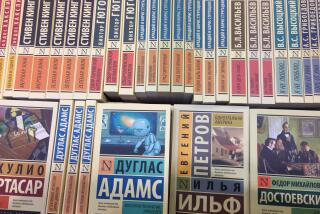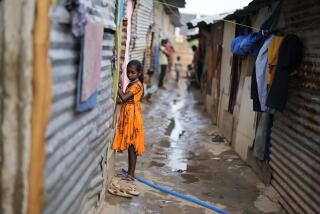In Russia, Jesus enters the classroom
- Share via
KOSTROVO, RUSSIA — Today they would learn about drawing, Russian Orthodox saints and God. The 7-year-olds sat straight at their desks, sun pouring through lace curtains and cherry trees blooming in the fields beyond. The teacher set a birch branch before the children and told them it was fragile and unique, just like their souls.
“If you think you can’t draw properly, who will help you?” she asked.
“God will help us,” a boy called out.
“Yes, God will guide your hand, so be confident, have faith.”
This is Tuesday, one of the two days a week dedicated to Orthodox education at this sleepy public school in the lush forests outside Moscow. All the girls and women have forgone pants in favor of skirts, and every student is learning Christian catechism along with reading, writing and arithmetic.
It’s an unlikely scene, not least because this is a public school in a country that, just a few decades back, prided itself on institutional atheism. It’s also a strange sight because as many as half of the pupils are Muslim, with a few Jews, Buddhists and nonbelievers mixed in. Many of their families arrived recently from Central Asia and the Caucasus in search of better schools and jobs.
At school, the students paint massive murals of Jesus, memorize myriad details about Orthodox saints and discuss New Testament stories with the local priest, who barrels into class in flowing black robes to oversee the students’ spiritual formation. At home, some of the children are learning to read the Koran in Arabic.
“Some of the parents doubted. Some were against it,” school administrator Natalia Korolchenko said. “But I told the parents, because more and more children of different nationalities are coming, something should unite them. Something should be done to make them respect the culture of this country.”
Pictures of Jesus, saints
Whereas the United States has haggled over prayer in schools, many Russian schools have swung wildly from Marxist havens to institutions steeped in Orthodox symbols and doctrine. With pictures of Jesus and the saints displayed on the walls, Kostrovo’s public school probably would be mistaken for a parochial institution by an uninformed visitor.
The struggle over the national religion is playing out across this vast country. A grass-roots movement driven by eager priests and local school officials has brought “Basics of Orthodox Culture” classes to regions throughout Russia in recent years.
The constitution orders the separation of church and state, but many observers believe that the gap is narrowing. Under the eight-year presidency of Vladimir Putin, who is rumored to be a fervent believer, Orthodox leaders took on a new prominence. They blessed the military, praised the country’s rulers, encouraged priests to work on behalf of national interests and carefully avoided any criticism of the government’s human rights or democracy record.
In exchange, the government and oligarchs close to the Kremlin have lavished the patriarchy with cash to restore monasteries and churches that went to seed during the Soviet era. An Orthodox construction boom is underway across the country.
The government has so far avoided entanglement in a growing debate over whether the classes are appropriate for public education. The decision over whether to add them -- and the nebulous question of where culture ends and theology begins -- has been left in the hands of local school officials.
The advent of religious education has provoked outcry from diverse segments of Russian society: Communists, Muslim and Jewish leaders and wary educators have raised alarms over the growing popularity of the classes.
“This seriously affects the unity of the country,” said Arsan Sadriyev of the Russian section of the Spiritual Directorate of European Muslims. “This will lead to the breakup of the country. Ethnic groups will consolidate themselves and look for ways to protect their interests.”
But supporters believe that the courses in Orthodox history and culture will unify Russia by filling an ideological void left by the collapse of the Soviet Union. Orthodox Christianity is the defining core of Russian history and identity, they say, and should be a compulsory subject for every student. Muslim immigrants from Central Asia and the Caucasus are in particular need of Orthodox understanding, they contend, so they can grasp the culture of their new home.
“If we go to Turkey, we must learn the basics of Islamic culture,” school administrator Korolchenko said. “When children come here, they should learn Orthodox culture. It will be easier for them.”
Clerics are locked in debate with the Education Ministry over whether the Orthodox courses should be discontinued or standardized, said Archpriest Vsevolod Chaplin, a spokesman for the Moscow patriarchy.
“Some people are afraid of any religion in the schools,” he said. “They still want to keep the monopoly of materialism and positivism that existed in Soviet times.”
A flood of newcomers
But Russia itself is changing. In Soviet days, this bucolic town was home to a homogenous population of ethnic Russian families who made their living working at the government cattle farm.
Today this region of rolling, fertile hills has been flooded with newcomers: Chechens, Azerbaijanis, Armenians, Tajiks and Uzbeks. Korolchenko declares, proudly, that the school is no less dogmatic today than it was when she arrived 30 years ago as a Communist Party member. But now, instead of communism and agriculture, the school is teaching religion to give the children a moral framework.
“If you understand the general Christian dogmas and the moral code of communism, it’s the same thing,” she said.
The federal government has made its approval plain. In 2004, the Education Ministry presented the school with an award for “spiritual and moral rebirth of village residents.”
The town’s priest, Vadim Sorokin, is also a former Communist who was an adult when he was baptized. He came to Kostrovo in 1995 and set about reconstructing the ruined hulk of St. Nicholas the Sanctifier Church.
Today, sunlight streams through intricately painted cupolas. Gold chandeliers dangle from an ornate ceiling, throwing light on icons etched with a wolf’s fang and set in hand-carved mahogany.
The renovation cost millions of dollars, all donated by the government and wealthy businesspeople. Sorokin started out buying books for the school and slowly worked up to introducing the Orthodox culture classes in 2003.
He haunts the hallways on appointed days, popping from class to class as the pupils, ages 7 to 17, talk about saints and souls.
In an upstairs classroom, Sorokin beamed as teenagers in the oldest class thrashed through a theological discussion.
“What did Cain and Abel do?” the teacher grilled them. “They both brought gifts to God. So what was the difference?”
“Sincerity and lack of sincerity,” one of the girls called out, springing to her feet and then sitting again.
“Good kids!” the teacher exclaimed. “You understand!”
--
More to Read
Sign up for Essential California
The most important California stories and recommendations in your inbox every morning.
You may occasionally receive promotional content from the Los Angeles Times.













